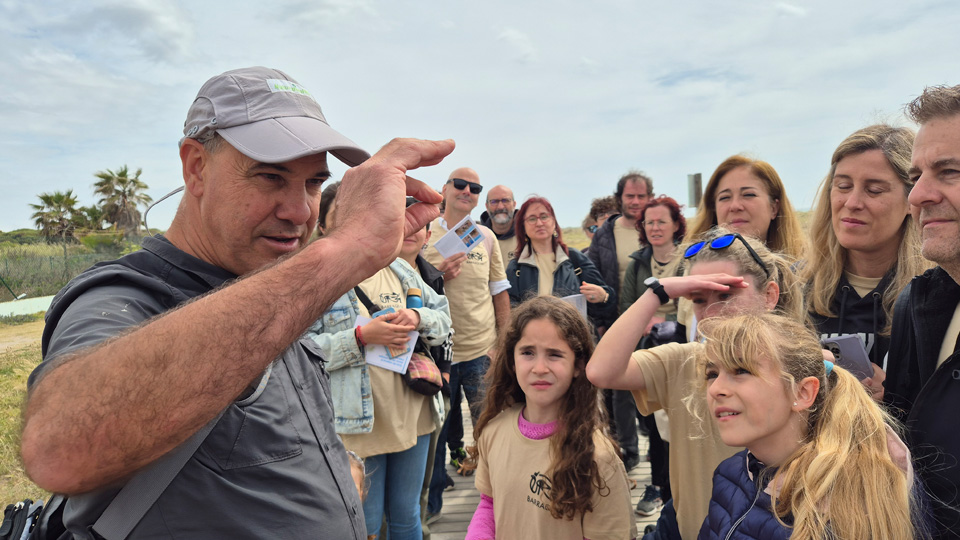Refraction or prescription
31/03/2025

12/12/2024
This year, as part of the Tinguem Vista project, Barraquer has collaborated with BioMARató "Beaches with Life", a citizen science initiative led by ICM-CSIC, aimed at cataloguing marine and coastal biodiversity in Catalonia. This effort helps to highlight the richness of our natural environment and raise awareness of the impacts of climate change.
The citizen science event marked its fourth edition this year, with a total of 91,211 observations, 1,731 species, and over 480 participants. Among the most significant findings, the Canary parrotfish (Sparisoma cretense) was detected for the first time in Catalonia, spotted in Blanes. Additionally, the fireworm (Hermodice carunculata), a marine polychaete that can grow up to 30 centimetres and has stinging bristles on its body, was observed in the SES Underwater Park in Tarragona. Both species originate from tropical and subtropical waters, serving as clear evidence of the warming of the Catalan coastal sea. Citizen collaboration has also helped document other species that indicate climate change effects and disrupted biological cycles, such as the premature ovulation of gorgonians or the early flowering of Posidonia oceanica.
The initiative, which collects all observations on the MINKA citizen science platform, has benefited from the support of organisations such as the Catalan Federation of Underwater Activities (FECDAS), Oceánicos Association, Plàncton Diving, and Anèl·lides – Marine Environmental Services, organising snorkelling and diving photography trips in Girona, Barcelona, and Tarragona.
A New Invasive Algae from Asia Reaches Catalonia
The mobilisation of underwater photography enthusiasts has also led to the identification and documentation of the invasive Asian algae Rugulopteryx okamurae. It was first detected in Catalonia at the Port of Llançà by a Pharmacology team from the University of Barcelona (UB). It was later found in La Farella, outside the port area, and subsequently recorded in MINKA, after a participant spotted it at the Port of Colera.
Tropical Species and Disrupted Biological Cycles
The event also recorded evidence of warm-water species appearing along the Catalan coast. A clear example is the Brazilian salema (Kyphosus saltatrix), observed in SES Park in Tarragona. Another notable sighting was the purple starfish (Ophidiaster ophidianus), a subtropical species rarely found in Catalonia, seen in l’Ametlla de Mar.
"The advantage of having hundreds of eyes underwater observing marine life is that we can capture important biological processes in certain species that reveal the effects of climate change," says Jaume Piera, a researcher at ICM-CSIC and coordinator of BioMARató.
For example, in Llafranc, the red gorgonian (Paramuricea clavata) has been observed ovulating earlier than usual, and in L'Ametlla de Mar, it has been confirmed that Posidonia oceanica begins to flower nearly two months earlier than usual. Another sign of rising water temperatures is coral bleaching, as observed in the Mediterranean stony coral (Cladocora caespitosa) in Tossa de Mar, a phenomenon that can prevent reproduction and ultimately lead to death.
A particularly noticeable trend in 2024 was the increased presence of rays. During the BioMARató, more than 15 sightings of the pelagic stingray (Pteroplatytrygon violacea) were recorded in Catalonia, including in Barcelona waters. This species, typically found in the open sea, is increasingly approaching the coast due to rising sea temperatures, seeking calm waters for gestation. Although not dangerous, their presence has led to several beach closures. In contrast, other ray species, such as the undulate ray (Raja undulata), are negatively affected by warm waters, with sightings in Catalonia becoming increasingly rare.
Citizen Science Helps Document Rare Findings
Other unusual or rare phenomena recorded thanks to citizen participation include the flowering of the seagrass (Cymodocea nodosa) in L'Ametlla de Mar, a highly unusual and difficult-to-witness event. Additionally, specimens of the striped false barnacle (Conchoderma virgatum) were observed attached to floating objects along the Costa Brava, despite being a rare species. A participant of BioMARató also documented a white ascidian (Rhopalaea neapolitana), a species typically found in deep waters. Finally, an accidental capture of a juvenile basking shark (Cetorhinus maximus) was recorded in L'Ametlla de Mar, a species of interest for studying its migration patterns and juvenile recruitment.
The End of BioMARató 2024
After four editions, BioMARató has compiled records of over 2,300 different species along the Catalan coastline, all registered on MINKA. This initiative has become Spain’s most data-rich participatory observatory of marine and coastal biodiversity and the most comprehensive in the Mediterranean. Currently, it holds over 250,000 verified marine observations along the Catalan coast, with all data openly accessible to the scientific community.